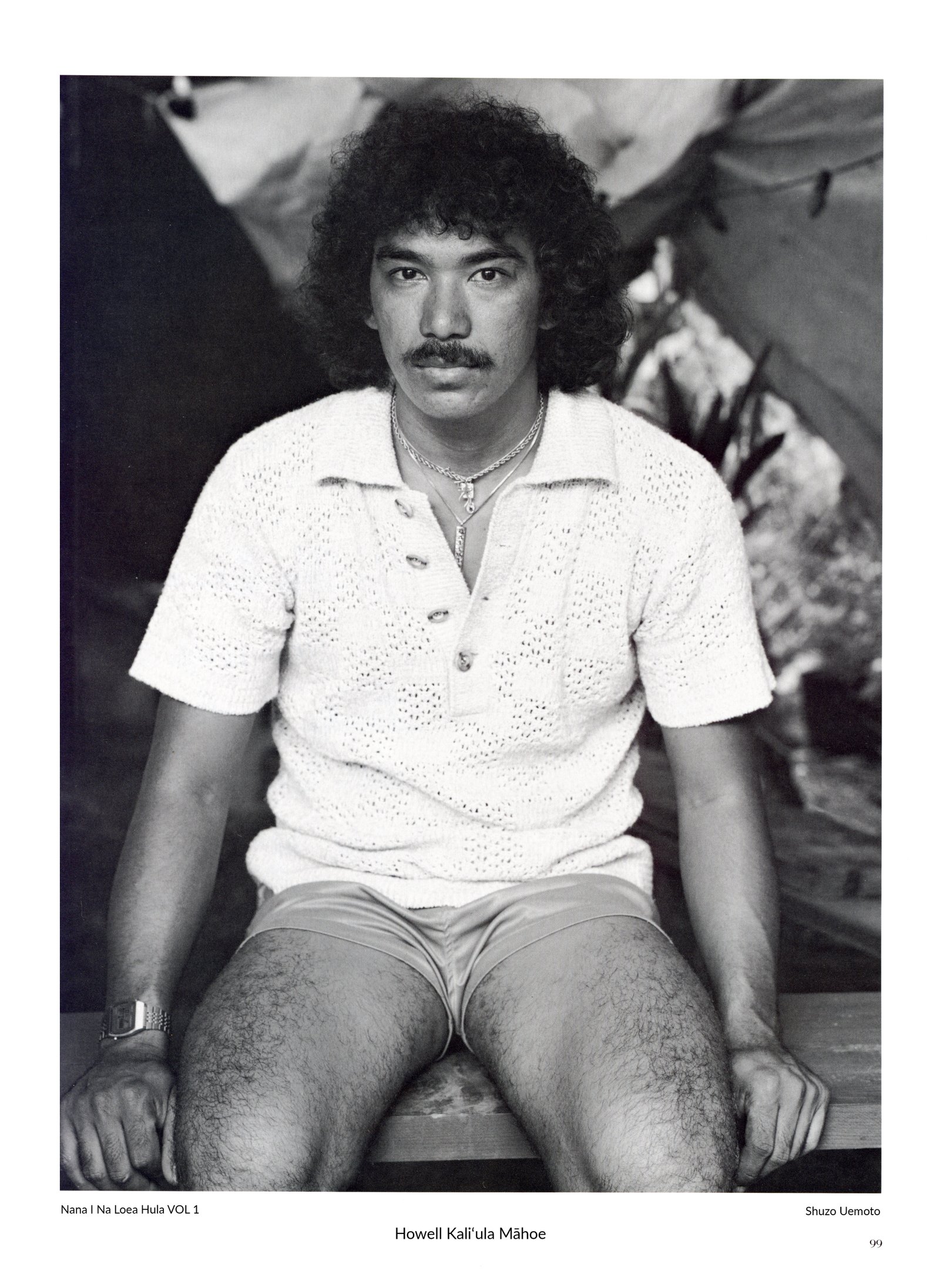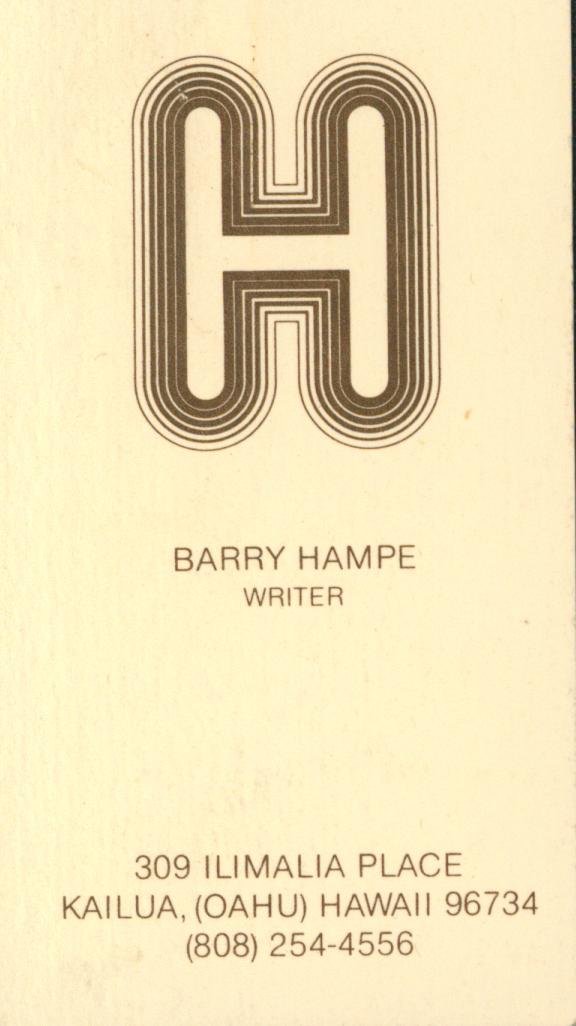Howell Kali‘ula Māhoe
Title
Howell Kali‘ula Māhoe
Description
Howell Kali‘ula Māhoe
“Chinky” Māhoe established his halau Kawailiula four years ago and is presently teaching in Kailua, Oʻahu.
The hula kahiko of today is a modernized form. To me, nobody knows how the hula was danced in ancient times. People can only retrace so much and what they recover has been interpreted to them by somebody else. When you enter some competitions today they categorize the kahiko into a certain period. To me the boundaries they set up are very ambiguous and inconsistent. Are you going to limit kahiko to the Kamehameha reign or set the limits at the Kalākaua reign? Why should one be included and the other excluded? Somebody at that time had to dream up the motions and the steps so why can’t the kumu create now because today’s kahiko has to be a combination of modern ideas and traditional movement. We wouldn’t be doing anything different than the kumu of fifty or a hundred years ago did not do themselves.
After I graduated from Kailua High School, I began to work at the Kāne‘ohe Marine Base. I started to fall into a rut and I looked at all the people around me, and I told myself I was too young to be growing old. I worked at the Kāne‘ohe Marine Base for two and a half years and then I quit. I went down to the beach and I just wanted to be a bum. I bodysurfed, grew my hair long, and played ‘ukulele. After seeing a performance by Robert Cazimero’s Nā Kamalei, I went to see Robert and later Kaha‘i Topolinski to enroll in hula. I didn’t know that there were specific times for new members to be accepted into their hālaus and both told me to wait for the next registration. I was so anxious that I started training under Uncle George Nā‘ope at Kalihi-Pālama Culture & Arts Society. Uncle George would show us the motions and foot movement and we would just follow his lead. At that time I didn’t know anything and it was very hard for me to take in so much. Uncle George made the class a lot of fun. It wasn’t pressured and that’s what I needed at that time. A friend of mine who was also taking classes with Uncle George would come over and help me practice. He would remember the motions because everything was Greek to me. If it wasn’t for him I might have quit a long time ago.
I studied under Uncle George for a year but Kalihi-Pālama was a community group and I felt I needed the structure of a hālau. I heard about Darryl Uupenui’s hālau Waimapuna, so I went to see him and he took me in. Darryl felt once you knew the basic steps then the hand motions would just come naturally. We would go through hours and hours of just working on those basic foot movements. When we started to dance Darryl would explain what hand motions should be used at the different points in the chant and he would show us the hand motions. Then he would pick one of the students, explain to the dancer what was to be done, and the rest of the class would follow the dancer.
I began to teach in September of 1979 with a group of guys from the Kailua Madrigals. I went to Darryl for his consent and he said I could teach as long as it wasn’t hula taken from Waimāpuna. The students wanted kahiko so I went home and opened up the Pele and Hi‘iaka book and tried to find a chant that I could handle. The boys kept asking me for more numbers so I figured why not put together a hālau separate from the Madrigals. We started out with fourteen boys and by the third week we ended up with four. But those four stuck with me and we went out and did shows.
You want the dedicated ones because everyone wants to dance and they disappear when they find out how much work it is. I liked the style of Waimāpuna so I fashioned our practices around Darryl’s practices. I figured if that’s what it took to be successful then that’s what we would do. Duplication of success I guess.
I wanted my dancers to experience what I went through at Waimāpuna. My goal is competitions. To me that is the highlight and reward of dancing. Win or lose, just to be a part of it. I think the only thing that matters is that the aaudience appreciates the dance.
“Chinky” Māhoe established his halau Kawailiula four years ago and is presently teaching in Kailua, Oʻahu.
The hula kahiko of today is a modernized form. To me, nobody knows how the hula was danced in ancient times. People can only retrace so much and what they recover has been interpreted to them by somebody else. When you enter some competitions today they categorize the kahiko into a certain period. To me the boundaries they set up are very ambiguous and inconsistent. Are you going to limit kahiko to the Kamehameha reign or set the limits at the Kalākaua reign? Why should one be included and the other excluded? Somebody at that time had to dream up the motions and the steps so why can’t the kumu create now because today’s kahiko has to be a combination of modern ideas and traditional movement. We wouldn’t be doing anything different than the kumu of fifty or a hundred years ago did not do themselves.
After I graduated from Kailua High School, I began to work at the Kāne‘ohe Marine Base. I started to fall into a rut and I looked at all the people around me, and I told myself I was too young to be growing old. I worked at the Kāne‘ohe Marine Base for two and a half years and then I quit. I went down to the beach and I just wanted to be a bum. I bodysurfed, grew my hair long, and played ‘ukulele. After seeing a performance by Robert Cazimero’s Nā Kamalei, I went to see Robert and later Kaha‘i Topolinski to enroll in hula. I didn’t know that there were specific times for new members to be accepted into their hālaus and both told me to wait for the next registration. I was so anxious that I started training under Uncle George Nā‘ope at Kalihi-Pālama Culture & Arts Society. Uncle George would show us the motions and foot movement and we would just follow his lead. At that time I didn’t know anything and it was very hard for me to take in so much. Uncle George made the class a lot of fun. It wasn’t pressured and that’s what I needed at that time. A friend of mine who was also taking classes with Uncle George would come over and help me practice. He would remember the motions because everything was Greek to me. If it wasn’t for him I might have quit a long time ago.
I studied under Uncle George for a year but Kalihi-Pālama was a community group and I felt I needed the structure of a hālau. I heard about Darryl Uupenui’s hālau Waimapuna, so I went to see him and he took me in. Darryl felt once you knew the basic steps then the hand motions would just come naturally. We would go through hours and hours of just working on those basic foot movements. When we started to dance Darryl would explain what hand motions should be used at the different points in the chant and he would show us the hand motions. Then he would pick one of the students, explain to the dancer what was to be done, and the rest of the class would follow the dancer.
I began to teach in September of 1979 with a group of guys from the Kailua Madrigals. I went to Darryl for his consent and he said I could teach as long as it wasn’t hula taken from Waimāpuna. The students wanted kahiko so I went home and opened up the Pele and Hi‘iaka book and tried to find a chant that I could handle. The boys kept asking me for more numbers so I figured why not put together a hālau separate from the Madrigals. We started out with fourteen boys and by the third week we ended up with four. But those four stuck with me and we went out and did shows.
You want the dedicated ones because everyone wants to dance and they disappear when they find out how much work it is. I liked the style of Waimāpuna so I fashioned our practices around Darryl’s practices. I figured if that’s what it took to be successful then that’s what we would do. Duplication of success I guess.
I wanted my dancers to experience what I went through at Waimāpuna. My goal is competitions. To me that is the highlight and reward of dancing. Win or lose, just to be a part of it. I think the only thing that matters is that the aaudience appreciates the dance.
Citation
“Howell Kali‘ula Māhoe,” Nā Kumu Hula Archive, accessed October 15, 2025, https://nakumuhula.org/archive/items/show/68.




